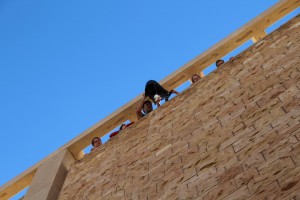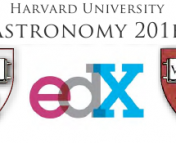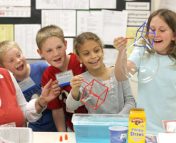I recently had the opportunity to plan a mission to a distant planet. The reasons for such drastic measures are endless: it’s likely that a meteorite is currently zooming toward us, zombies are taking over, or global warming is finally triumphing. We needed to find another habitable planet, determine the materials necessary for such a difficult mission, and plan for success. My crew? 6 bright and talented middle school students.
As you may have already guessed, I planned this mission at astrocamp (more formally known as the ExxonMobil – Bernard Harris Summer Science Camp). The camp funded 48 wonderful middle school level students for 10 days. All of whom were selected based on their G.P.A., personal statements, and letters of recommendation. Most campers traveled hundreds of miles to attend astrocamp at the University of Wyoming.
The theme of astrocamp is ‘Journey to the Stars.’ This allowed students to learn the vital reasons for leaving Earth and gain the skills necessary to do so. They selected a star that might possibly harbor a habitable planet, designed rockets, spacesuits, and landers for their journey, and finally explored and studied an alien landscape searching for signs of life.
The Mission
The first step in planning such a mission is determining the destination. We studied the HR Diagram and noted how stellar mass, temperature, and lifetime are related. By finding a star similar or cooler than our sun, we identified stars that have long lifetimes and may be suitable for the development of civilization. Not only did we need to find a star that could potentially harbor life, but we needed to find a nearby star. In order to do so, we studied parallax, and determined distances for stars in the Hipparcos catalogue. Once a good host star was found, campers imaged these stars directly. We spent a night at the Wyoming Infrared Observatory taking spectra of these stars. Throughout the evening, every camper had the opportunity to actually operate a 2.3m telescope!

Crew members test their planetary landers by launching them off of the Physical Sciences Building onto an alien landscape below.
The Journey
Never mind finding the right star system to travel to, what about the logistics of space travel? We focused on the challenges of spaceflight: determining the many hardships we might face. To begin campers had the opportunity to design rockets, launch their rockets, and then rebuild if necessary. Former astronaut Bernard Harris visited, giving students the opportunity to ask questions addressing spaceflight itself. We learned what food was available and even how to shower in space. Dr. Harris helped us design spacesuits impenetrable to micrometeorites. We tested our designs, and I’m sad to say that only a few astronauts survived such a daunting task. Our planetary landers however were much more successful; few eggs broke in the 4-story fall.
The Discovery
Once we find a good star system likely to host a habitable planet, and undergo the dangers of a journey there, what awaits? Here it’s important to understand the characteristics of life. And what a better place to explore an alien landscape than Wyoming itself, where the rock formations do look rather odd and life is scarce at 12,000 feet? We went on multiple hikes discussing places of shelter and looking for signs of life. We took samples of water and noted the difficulties in designing filtration systems. Lastly we tested for signs of life: proteins, bacteria, and moving organisms. We found that life is scarcer at high elevation than it is a little lower down (9,000 feet).
By the end of camp we had a better understanding of different star systems, and knew the difficulties we faced in finding a habitable planet. We understood the challenges we were likely to face in traveling to such a planet. Not only did we consider the resources necessary but the social implications as well. And lastly we knew what to look for when we reached such a planet. It’s an understatement to say that the campers learned a lot. One of my crew claimed that she had “learned more in one day here than in a week at school.”
The goal of camp was not just to learn but to inspire. It was to equip these future scientists with the tools needed to succeed. It was common to hear such phrases as: “that blew my mind” throughout camp. Science was interactive and fun. And judging by the tears left on many campers’ faces when saying goodbye, I would say it was a success. I was more surprised, however, by the way in which these campers inspired me. Their enthusiasm and love for science never dwindled. If a task was difficult, they would only attack it with more fervor. One team member would state: “challenge accepted” and the crew would be busy in work. It is a truly refreshing and rewarding outlook on science.




